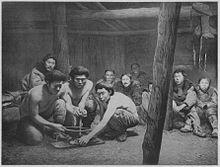
Back Koryaklar Azerbaijani کوریاکلار AZB Каракі Byelorussian Коряки Bulgarian Koriaks Catalan Korjaci Czech Korjaken German Κοριάκες Greek Koriakos Spanish Korjakid Estonian
 Koryak ceremony of starting the New Fire | |
| Total population | |
|---|---|
| 7,554 | |
| Regions with significant populations | |
| 7,485 (2021 census)[1] | |
| 69 (2001 census)[2] | |
| Languages | |
| Russian, Koryak | |
| Religion | |
| Predominantly Russian Orthodox Christianity also Shamanism | |
| Related ethnic groups | |
| other Chukotko-Kamchatkan peoples | |

Koryaks (Russian: коряки) are an Indigenous people of the Russian Far East, who live immediately north of the Kamchatka Peninsula in Kamchatka Krai and inhabit the coastlands of the Bering Sea.[citation needed] The cultural borders of the Koryaks include Tigilsk in the south and the Anadyr basin in the north.
The Koryaks are culturally similar to the Chukchis of extreme northeast Siberia.[3] The Koryak language and Alutor (which is often regarded as a dialect of Koryak), are linguistically close to the Chukchi language. All of these languages are members of the Chukotko-Kamchatkan language family. They are more distantly related to the Itelmens on the Kamchatka Peninsula. All of these peoples and other, unrelated minorities in and around Kamchatka are known collectively as Kamchadals.
Neighbors of the Koryaks include the Evens to the west, the Alutor to the south (on the isthmus of Kamchatka Peninsula), the Kerek to the east, and the Chukchi to the northeast.[citation needed]
The Koryak are typically split into two groups.[citation needed] The coastal people are called Nemelan (or Nymylan) meaning 'village dwellers', due to their living in villages. Their lifestyle is based on local fishing and marine mammal hunting. The inland Koryak, reindeer herders, are called Chaucu (or Chauchuven), meaning 'rich in reindeer'. They are more nomadic, following the herds as they graze with the seasons.[4]
According to the 2010 census, there were 7,953 Koryaks in Russia.
- ^ "Оценка численности постоянного населения по субъектам Российской Федерации". Federal State Statistics Service. Retrieved 31 August 2024.
- ^ [1] State statistics committee of Ukraine - National composition of population, 2001 census] (Ukrainian)
- ^ "Chukchi". Minority Rights Group. Retrieved 21 January 2024.
- ^ Chaussonnet 1995, p. 28-29.